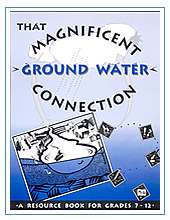Water Conservation Tips for Schools
Schools use a tremendous amount of water everyday, and require water for their heating and cooling systems, restrooms, drinking water faucets, locker rooms, cafeteria, laboratories, and outdoor playing fields and lawns. To reduce water use in the school, consider replacing old equipment such as dishwashers with energy-saving devices. Repair water leaks and leaky toilets. Install water aerators and automatic shut-off devices on faucets. Use low-flow shower heads and timer shut-off devices to reduce water use during showers. Install toilet dams on older models.
EPA also offers assistance about ways to reduce health hazards in schools through its Tools for Schools and Toxic Free Schools Programs.
At the request of teachers for additional classroom activities related to ground water, the EPA Region 1 New England Office provided grants to the New England Interstate Water Pollution Control Commission to develop classroom activity books for grades K-6 and 7-12. These books, entitled, "That Magnificent Ground Water Connection," include background information for teachers and several student activities introducing water conservation principles.
To reduce outdoor water use, maximize natural vegetative cover, and limit the amount of lawn area provided. Maintain playing fields using drought-tolerant grasses. Other outdoor water tips follow:
- Maximize the use of natural vegetation and establish smaller lawns. For portions of your lot where a lawn and landscaping are desired, ask your local nursery for tips about plants with low water demand. Consider planting more trees, shrubs, ground covers, and less grass. Shrubs and ground covers provide greenery for much of the year and usually demand less water. Use native plants in flower beds. Native plants have adapted to rainfall conditions in New England and often provide good wildlife habitat. They also provide learning opportunities for students. Cluster plants that require extra care together to minimize time and save water.
- When mowing your lawn areas and playing fields, set the mower blades to 2-3 inches high. Longer grass shades the soil improving moisture retention, has more leaf surface to take in sunlight, allowing it to grow thicker and develop a deeper root system. This helps grass survive drought, tolerate inspect damage and fend off disease.
- Only water the lawn when necessary. If you water your lawn and flower beds, only do it once a week, if rainfall isn't sufficient. Avoid watering on windy and hot days. Water the lawn and flower beds in the morning or late in the evening to maximize the amount of water which reaches the plant roots (otherwise most of the water will evaporate). Use soaker hoses to water gardens and flower beds. If sprinklers are used, take care to be sure they don't water walkways and buildings. When you water, put down no more than 1 inch (set out a empty cans to determine how long it takes to water 1 inch) each week. This watering pattern will encourage more healthy, deep grass roots. Over-watering is wasteful, encourages fungal growth and disease, and results in the growth of shallow, compacted root systems that are more susceptible to drought and foot traffic. If an automatic lawn irrigation system is used, be sure it has been properly installed, is programmed to deliver the appropriate amount and rate of water, and has rain shut-off capability.
- Apply mulch around shrubs and flower beds to reduce evaporation, promote plant growth and control weeds.
- Add compost or an organic matter to soil as necessary, to improve soil conditions and water retention.
- Collect rainfall for irrigation in a screened container (to prevent mosquito larvae growth).
- Always use a broom to clean walkways, driveways, and entrances rather than hosing off these areas.

